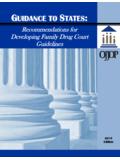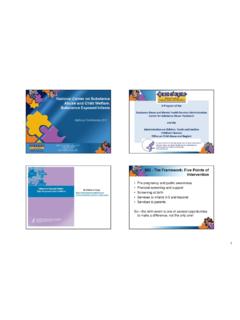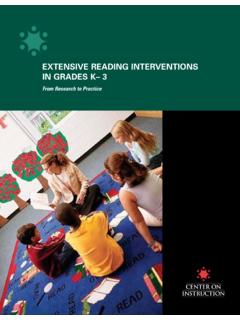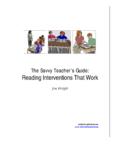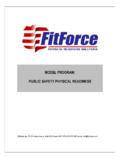Transcription of Collaborative Practice Model for Family Recovery, …
1 The Collaborative Practice Model for Family Recovery, Safety and Stability was developed by Children and Family Futures, a California-based policy research organization whose mission is to improve the lives of children and families, particularly those affected by substance use disorders. Children and Family Futures is the contractor to the Federal government operating the National Center on Substance Abuse and Child Welfare (NCSACW) and that experience is reflected in this document. The National Center on Substance Abuse and Child Welfare is an initiative of the Department of Health and Human Services and jointly funded by the Substance Abuse and Mental Health Services Administration s (SAMHSA) Center for Substance Abuse Treatment (CSAT) and the Administration on Children, Youth and Families (ACYF), Children s Bureau s Office on Child Abuse and Neglect (OCAN). Recommended Citation: Children and Family Futures (2011). The Collaborative Practice Model for Family Recovery, Safety and Stability.
2 Irvine, CA: and Family Futures4940 Irvine Boulevard, Suite 202, Irvine, CA 92620(714) (714) 505-3626 1 The Elements of System Linkages in Brief 3 Mission, Underlying Values, and Principles of Collaboration 5 Screening and Assessment 7 Engagement and Retention in Care 9 Services to Children of Parents with Substance Use Disorders 11 Working with the Community and Supporting Families 13 Efficient Communication and Sharing Information Systems 15 Budgeting and Program Sustainability 17 Training and Staff Development 19 Working with Related Agencies 21 Joint Accountability and Shared Outcomes
3 23 Resources and Tools for the Elements of System Linkages 25 Citations and References 37 Matrix of Progress: The Collaborative Practice Modelfor Family Recovery, Safety and Stability 39 Table of Contents1 Introduction The need for Collaborative Practice and policies for families with substance use disorders in child welfare was established by the Department of Health and Human Services in their 1999 Report to Congress, Blending Perspectives and Building Common They specified five national goals: Building Collaborative Working Relationships Assuring Timely Access to Comprehensive Substance Abuse Treatment Services Improving Our Ability to Engage and Retain Clients in Care and to Support Ongoing Recovery Enhancing Children's Services Filling Information Gaps. In the ensuing dozen years, Children and Family Futures, a nonprofit policy research and technical assistance organization, developed2 and refined a Collaborative Practice Model for families involved in the child welfare system, most of whom include at least one member with a substance use The Collaborative Practice Model is drawn from the experiences of communities who have implemented Practice and policy changes to accomplish the five national goals.
4 These innovators, drawing upon their in-depth understanding of the needs of the families who are the focus of their efforts, emphasize collaboration beyond the child welfare arena. The Model calls for collaboration among child welfare, Family treatment, and dependency courts, agencies, and providers. In this document, we discuss ten system linkage elements that child welfare, substance abuse treatment, and juvenile court dependency systems, as well as other agencies and providers working with these systems, should use to collaborate with one another. We define Collaborative Practice as the use of these ten system linkage elements by two or more systems, agencies, or providers to improve child and Family outcomes. The purpose of this document is to define and provide examples of Collaborative Practice in each of the ten system linkage elements. State and community Collaborative groups can use this information to guide their own efforts to implement Collaborative Practice in their own communities.
5 To achieve its mission of child safety, permanent care giving relationships and improved child well -being, child welfare agencies require a Collaborative approach. While families may face many challenges, substance use disorders are one of several co-occurring conditions that affect most families in the child welfare system, particularly when child removal is warranted. Thus, Collaborative Practice with substance abuse treatment agencies is necessary. The Model also calls for collaborations with the court system, mental health providers, and several other agencies whose resources can help achieve child welfare outcomes. Important among those other agencies are primary health, education, child development, domestic violence, and housing. Collaborative Practice in Child Welfare Settings Another reason why collaboration is so important to child welfare is that the system needs to supplement its overall resources with financial support from outside its control to meet families needs.
6 Chi ld and Family serving agencies require both public agency and community supports to fulfill their mission. Partner agencies often include law enforcement agencies, early childhood agencies, courts, and schools. But the system also needs non-financial support from families and other social networks including religious and community groups. Collaboration is not a useful add-on in child welfare; it is the critical link to resources that the system needs for success. IntroductionCollaborative Practice Model for Family Recovery, Safety and Stability Collaborative Practice in Substance Abuse Treatment Settings A wider circle of resources beyond the realm of treatment agencies is also critical to treatment success and continuing recovery for parents with a substance use or mental Parents of young children with substance use and co-occurring mental disorders and children affected by trauma often require treatment for longer periods than many agencies can provide alone.
7 In addition, many substance abuse treatment programs cannot offer the aftercare, longer-term case management, peer support, and community-based supportive services that these families need. Here too, Collaborative Practice can mobilize resources that are critical to achieving levels of interagency success that no single agency can achieve on its own. Collaborative Practice in Juvenile Dependency Court Settings The majority of children and adolescents in juvenile dependency courts have Family members with a substance use disorder. Courts might require these Family members to obtain treatment when children are placed in protective custody and decisions are made about terminating parental rights or reunifying families. Court officials sometimes seek to coordinate resources from multiple systems (including child welfare and substance treatment agencies) on behalf of the families they serve, and judges may offer incentives or impose sanctions that affect families needing coordinated services from more than one agency.
8 Judicial leaders can play important roles to create cooperative relationships and accountability reviews of what agencies working together have accomplished for families under the court s jurisdiction. Fiscal Context Fiscal reality is a critical factor in Collaborative Practice . Interagency work can be very resource intensive at first, regardless of its eventual cost savings due to increased efficiency and effectiveness. It is clear however that knowing the costs and savings in Collaborative Practice is A fiscal climate of budget cuts and spending freezes can make collaboration seem like a luxury, even when shared resources from several agencies have become critical to sustaining important programs. Agency consolidations can also impose barriers to interagency work because adjusting to these changes sometimes takes priority over working across agencies. Yet, fiscal strain can also create a new urgency for Collaborative efforts as agencies recognize the mutual advantages of sharing scarce resources to improve results.
9 Agencies with a record of improving results through collaboration can sometimes make a better case for preventing cutbacks to their programs. These agencies are also better positioned to create coalitions of supporters to expand their activities than agencies working alone through the documentation of the short- and longer-range cost savings of the collaboration. Framework for Collaborative Practice : The System Linkage Elements We have identified ten elements of Collaborative Practice based on our work with more than 150 States and communities since 1996. We provide a brief description of each of the ten elements in the next section. Subsequent sections describe each of the elements in detail and include examples from some of the many States and communities that have demonstrated progress in each element. At the end of the document, we provide a list of resources and tools that are available to systems, agencies, and providers to advance their Collaborative Practice and policies for improving child safety, permanency, and well-being and Family recovery.
10 We also provide a matrix that describes the potential characteristics and practices of systems, agencies, and providers that adopt a Collaborative Practice Model approach. Practice Model for Family Recovery, Safety and Stability3 The System Linkage Elements in Brief 1. Mission, Underlying Values, and Principles of Collaboration Each partner enters the collaboration with its own perspective on and assumptions about the mission and mandates of the other partners. Unless the partners identify and address these differences, they might have difficulty reaching agreement about Practice or systems issues. Values and definitions, such as who the primary client is, often affect the ways in which staff work across agency boundaries. The partners need to develop a joint mission for their activities based on common principles that govern how the agencies and their staff will work together to improve the outcomes for the families they serve. 2. Screening and Assessment During their first contacts with a Family member, agencies must begin determining what kind of substance use or mental disorder, if any, the child or adult has; what mode of treatment would be the best response to the problem; what information the partners need to communicate with other agencies; and, the risks and needs of the children of parents entering substance abuse treatment.
